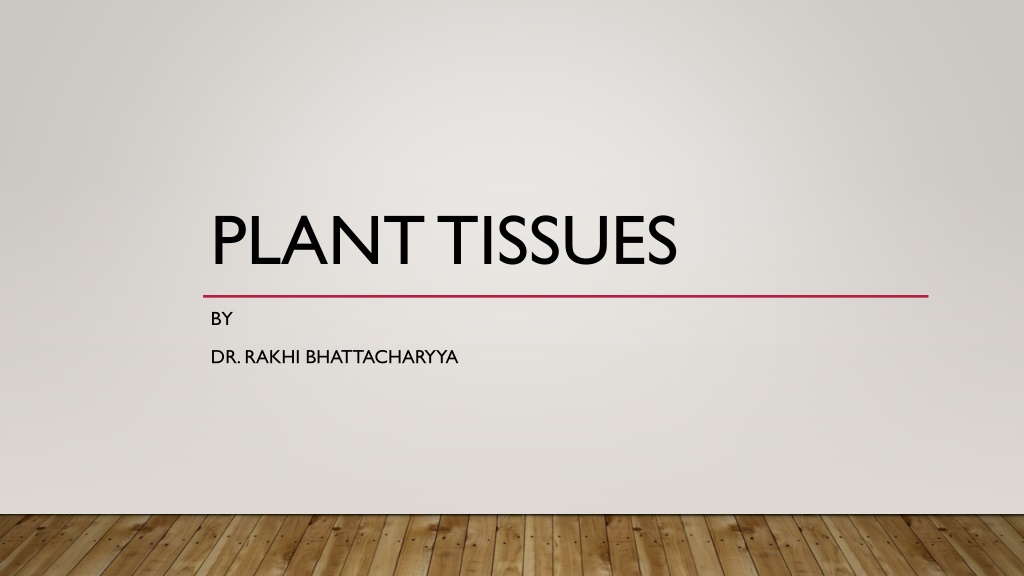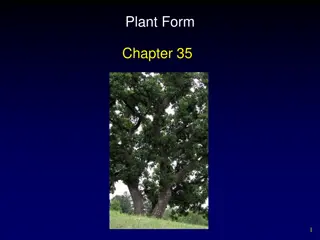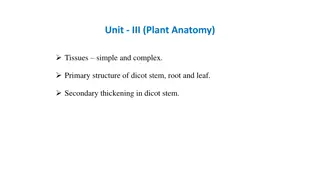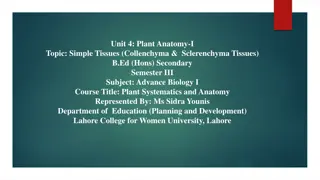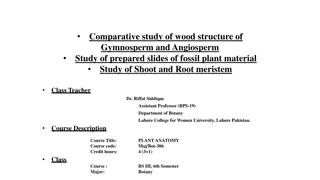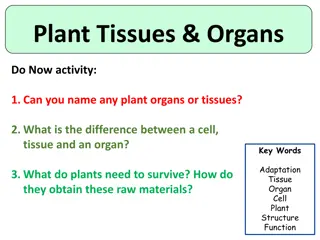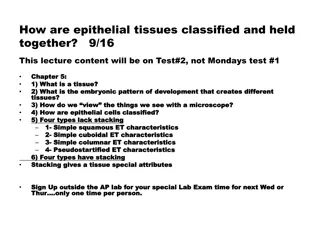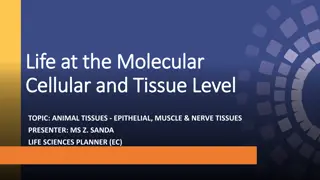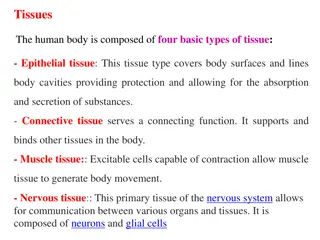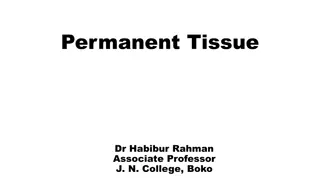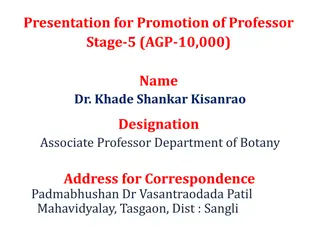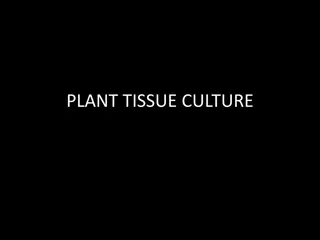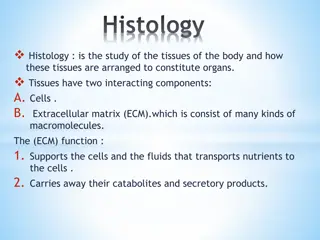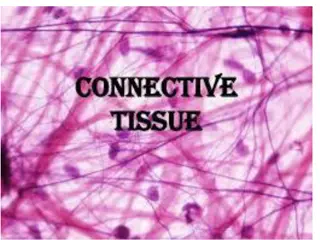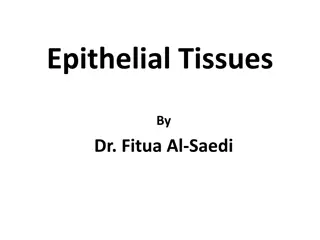Understanding Plant Tissues and Meristems in Botany
Plant tissues are groups of cells with similar structures and functions. They can be classified into meristematic, permanent, and secretory tissues. Meristems are regions of continuous cell division found in plant tips and cambium, essential for growth. Primary meristems are present from the embryo stage, promoting primary growth, while secondary meristems appear later for secondary growth, forming tissues like secondary xylem and cork cambium.
Download Presentation

Please find below an Image/Link to download the presentation.
The content on the website is provided AS IS for your information and personal use only. It may not be sold, licensed, or shared on other websites without obtaining consent from the author. Download presentation by click this link. If you encounter any issues during the download, it is possible that the publisher has removed the file from their server.
E N D
Presentation Transcript
PLANT TISSUES BY DR.RAKHI BHATTACHARYYA
PLANT TISSUES Groups or masses of the cells that are alike in region, structure and function form tissue. From the study point of view, the tissues may be grouped into three principal groups: 1. Meristems or meristematic tissues 2. Permanent tissues 3. Secretory tissues The term tissue was coined by Grew.
MERISTEM Meristem is a Greek word Meristosis meaning to divide. A region of plant tissue, found chiefly at the growing tips of roots and shoots and the cambium consisting of actively diving cells forming a new tissue. A meristematic tissue consists of a group of cells which remain in continuous state of division or they retain their power of division.
CHARACTERISTICS OF MERISTEMS Composed of immature cells which are state of division and growth. Intercellular spaces are absent. Cells are rounded, oval or polygonal in shape. Cells are always living and thin walled. Each cell has abundant cytoplasm and one or more nuclei. The cells are capable of regular and continuous mitotic division.
CLASSIFICATION OF MERISTEM The meristematic tissue is mainly classified on the basis of origin and location in the plant body. 1. Based on origin 2. Based on location (or position)
BASED ON ORIGIN Based on origin, meristems can be classified into the following two types: 1. Primary Meristem 2. Secondary Meristem
PRIMARY MERISTEM It is the meristem present at right from the embryonic stage. Active throughout the life of plants. Responsible for primary growth in the plant body. It gives rise to primary tissue of the plant body.
SECONDARY MERISTEM It is the meristem that appears later in life cycle of a plant. It is responsible for secondary growth in the plant body. It gives rise to secondary permanent tissues such as secondary cortex and secondary xylem. E.g. Cork Cambium and vascular cambium.
BASED ON LOCATION (OR POSITION) Apical Meristem Intercalary Meristem Lateral Meristem
APICAL MERISTEM It is the meristem present at the tip of the root and stem, commonly called as root apex and shoot apex. Such meristems constitute the actively growing regions in the plant body. Due to the activity of apical meristem the plant body keeps increasing in its length.
INTERCALARY MERISTEM It is the meristem that occurs between permanent tissues. It may also occur at the base of the leaves. It is particularly common at the nodal regions. It is also responsible for the formation of branches at the nodal regions. The apical and intercalary meristems are examples of primary meristem.
LATERAL MERISTEM The lateral meristems are composed of such initials which divides in mainly in one plane (periclinally) and increase in the diameter of an origin. This is responsible for growth in the thickness of plant body.
PERMANENT TISSUES They are composed of living or dead cells which are derived from the meristematic tissue but have lost the ability to divide. They are primary permanent tissues, if they are derived from apical or intercalary meristem. They are secondary permanent tissues if they are derived from lateral meristem. Permanent tissues are mature cells with permanent special structure and function. These are of two types: 1. Simple Tissues 2. Complex Tissues
SIMPLE TISSUES: Classified into 3 types: 1. Parenchyma 2. Collenchyma 3. Sclerenchyma
PARENCHYMA These cells are found almost in all parts of plants such as roots, stem, leaves and seeds. The cells are spherical, oval or polygonal with intercellular spaces. These cells are living with thin cellulosic cell wall. FIGURE 2
COLLENCHYMA The cells have thickenings on the cell wall and in corners of intercellular spaces. It is mechanical tissue. They are not found in roots and monocot stems. These cells form hypodermis in stem and petiole. The thickening material in the cell wall contains high amount of pectin and cellulose. Lignin is absent. FIGURE 3
SCLERENCHYMA These cells have thickened secondary walls due to deposition of lignin. At maturity they become dead. These cells have simple pits.They are classified into two types: Sclereids: They may be spherical, oval and cylindrical. They are lignified and extremely thick walled. So the lumen of the cells is almost obliterated. They are found in hard parts of the plants. Sclerenchymatous fibres: They are long with tapering ends. These are thick cells (lignified). The fully developed fibre cells are always dead. The length of fibre varies from 2-550 mm in angiosperms and 1 to 12 mm in gymnosperms. The main function is mechanical strength.
FIGURE 4 FIGURE 5
COMPLEX TISSUES They are made up of different types of cells working as a unit to perform a common function. Classified into two types: 1. Xylem 2. Phloem
XYLEM It is the chief water conducting element and also provide mechanical strength. Xylem consist of four different types of cells. 1. Tracheids: They are elongated cells with pointed chisel like ends. Having no perforations. Their wall is tough, thickened, lignified and thickening may be annular, spiral, reticulate, scalariform or pitted. Cells are dead at maturity and have bordered pits. In pteridophytes and gymnosperms, wood mainly consists of tracheids (no vessels). In angiosperms, tracheids are associated with vessels. The main function is conduction of water. And are the most primitive type of conducting elements in xylem.
2. Vessels: They are elongated and tube like, formed from a row of cells placed end to end. The partition walls are either perforated or disappear altogether, resulting in an elongated tube. Walls are thickened and lignified. 3. Wood or xylem fibre: These cells are elongated and pointed at both the ends. Cells are highly lignified. They are commonly found in secondary xylem. 4. Wood or xylem parenchyma: They are living parenchymatous cells associated with xylem. They may occur as axial parenchyma or ray parenchyma.
PHLOEM It is the main food conducting tissue and consist of following types of cells: 1. Sieve element: The sieve elements in angiosperms are sieve tubes which are cylindrical tubelike cells with perforated cross walls called sieve plate. Sieve tubes are associated with companion cells and they are without nuclei. P-Proteins are present. 2. Companion cells: They are elongated, living, parenchymatous, thin walled cells. They are associated laterally to sieve tubes and dense cytoplasm and nuclei. Companion cells are absent in pteridophytes and gymnosperms. Both Sieve tube and companion cells are called as sister cells.
3. Phloem or bast fibre: They are absent or fewer in primary phloem and abundantly found in secondary phloem. 4. Phloem parenchyma: They are parenchymatous living cells with cellulosic cell wall and nucleus. The main function is storage of food.
FIGURE 7 FIGURE 8
SECRETORY TISSUES They are classified into mainly two types: 1. Laticiferous tissues: Latex vessels of Calotropis, Euphorbia, Hevea, Argemone etc. 2. Glandular tissues: Oil glands of Citrus species and Eucalyptus, resinous ducts in Pinus, mucilage secreting glands of Piper betel etc.
